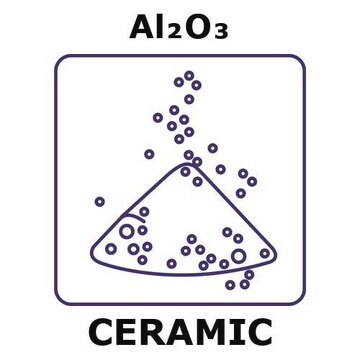Kluczowe dokumenty
702129
Aluminum oxide
nanoparticles, <50 nm particle size (DLS), 20 wt. % in isopropanol
Synonim(y):
Alumina
About This Item
Polecane produkty
Formularz
dispersion
nanoparticles
stężenie
20 wt. % in isopropanol
wielkość cząstki
<50 nm (DLS)
pH
8-10
gęstość
0.79 g/cm3 at 25 °C
ciąg SMILES
O=[Al]O[Al]=O
InChI
1S/2Al.3O
Klucz InChI
TWNQGVIAIRXVLR-UHFFFAOYSA-N
Szukasz podobnych produktów? Odwiedź Przewodnik dotyczący porównywania produktów
Opis ogólny
Zastosowanie
- Elemental analysis of levitated solid samples by microwave-assisted laser induced breakdown spectroscopy.: This study explores the application of aluminium oxide in enhancing the elemental analysis capabilities of laser induced breakdown spectroscopy, providing a novel approach for high precision chemical analysis in analytical chemistry (Alamri AM et al., 2024).
- An ab initio molecular dynamics investigation of the behaviour of amorphous substances in anodic aluminium oxide under electric field.: This research presents a molecular-level understanding of how amorphous substances behave within anodic aluminium oxide structures when subjected to an electric field, offering insights into the material′s stability and reactivity (An Z et al., 2024).
- Alternative nano-lithographic tools for shell-isolated nanoparticle enhanced Raman spectroscopy substrates.: The article discusses the utilization of aluminium oxide in the development of advanced nano-lithographic tools, significantly enhancing the performance of Raman spectroscopy for chemical detection and analysis (Srivastava K et al., 2024).
- Unexpected early loosening of rectangular straight femoral Zweymüller stems with an alumina-reduced surface after total hip arthroplasty-a prospective, double-blind, randomized controlled trial.: This study examines the clinical implications of using aluminium oxide in prosthetic implants, specifically its effect on the longevity and stability of femoral stems in hip arthroplasty (Moret CS et al., 2024).
- Green Synthesis of Aluminum Oxide Nanoparticles Using Clerodendrum phlomidis and Their Antibacterial, Anti-inflammatory, and Antioxidant Activities.: Investigates the biogenic synthesis of aluminium oxide nanoparticles, highlighting their potential in biomedical applications due to their antibacterial, anti-inflammatory, and antioxidant properties (Thanaraj S et al., 2024).
Hasło ostrzegawcze
Danger
Zwroty wskazujące rodzaj zagrożenia
Zwroty wskazujące środki ostrożności
Klasyfikacja zagrożeń
Eye Irrit. 2 - Flam. Liq. 2 - STOT SE 3
Organy docelowe
Central nervous system
Kod klasy składowania
3 - Flammable liquids
Klasa zagrożenia wodnego (WGK)
WGK 1
Temperatura zapłonu (°F)
53.6 °F - closed cup
Temperatura zapłonu (°C)
12 °C - closed cup
Środki ochrony indywidualnej
Eyeshields, Faceshields, Gloves, type ABEK (EN14387) respirator filter
Wybierz jedną z najnowszych wersji:
Masz już ten produkt?
Dokumenty związane z niedawno zakupionymi produktami zostały zamieszczone w Bibliotece dokumentów.
Klienci oglądali również te produkty
Produkty
Hydrogen is one of the most important resources in providing food, fuel, and chemical products for our everyday life. Sustainable catalytic hydrogen production from bioethanol has gained significant attention in recent years due to globally diminishing fossil fuel supplies, which have necessitated the search for new chemical feedstocks.
Among various ceramics, one-dimensional (1-D) piezoelectric ceramics have attracted significant scientific attention for use in energy harvesting.
TiO2 wykazuje właściwości półprzewodnika o szerokim paśmie wzbronionym i memrystora elektronicznie, z wysoką nieprzezroczystością i absorpcją UV optycznie.
Electronically, it behaves as a wide band gap (3.2 eV) semiconductor and exhibits memristor properties.2 Optically, TiO2 has high opacity with a very high refractive index3 (>2.4), and it exhibits strong absorbance in the UV range.
Nasz zespół naukowców ma doświadczenie we wszystkich obszarach badań, w tym w naukach przyrodniczych, materiałoznawstwie, syntezie chemicznej, chromatografii, analityce i wielu innych dziedzinach.
Skontaktuj się z zespołem ds. pomocy technicznej





